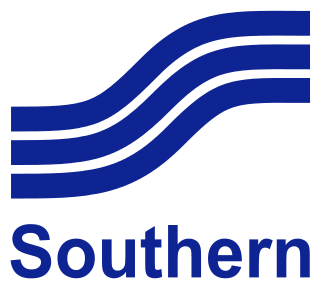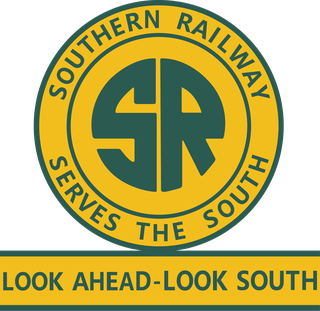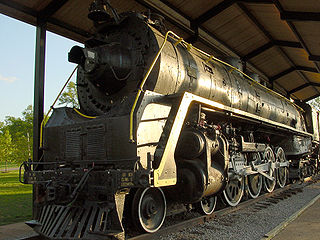
Interstate 59 (I-59) is an Interstate Highway located in the southeastern United States. It is a north–south route that spans 445.23 miles (716.53 km) from a junction with I-10 and I-12 at Slidell, Louisiana, to a junction with I-24 near Wildwood, Georgia.

Southern Airways was a local service carrier, a scheduled airline certificated by the federal Civil Aeronautics Board, in the United States, from its founding by Frank Hulse in 1949 until 1979, when it merged with North Central Airlines to become Republic Airlines. Southern's corporate headquarters were in Birmingham, with operations headquartered at Hartsfield–Jackson Atlanta International Airport, near Atlanta.

U.S. Route 11 or U.S. Highway 11 (US 11) is a major north–south United States Numbered Highway extending 1,645 miles (2,647 km) across the eastern U.S. The southern terminus of the route is at US 90 in Bayou Sauvage National Wildlife Refuge in eastern New Orleans, Louisiana. The northern terminus is at the Rouses Point–Lacolle 223 Border Crossing in Rouses Point, New York. The route continues across the border into Canada as Route 223. US 11, created in 1926, maintains most of its original route. The route north of Knoxville, Tennessee, follows a route similar to Interstate 81 (I-81). While it is signed as a north–south route, it physically travels in a northeast–southwest direction.

The Crescent is a daily long-distance passenger train operated by Amtrak between New York City and New Orleans. The 1,377-mile (2,216 km) route connects the Northeast to the Gulf Coast via the Appalachian Piedmont, with major stops in Charlotte, North Carolina; Atlanta, Georgia; and Birmingham, Alabama.

The Southern Railway was a class 1 railroad based in the Southern United States between 1894 and 1982, when it merged with the Norfolk and Western Railway (N&W) to form the Norfolk Southern Railway. The railroad was the product of nearly 150 predecessor lines that were combined, reorganized and recombined beginning in the 1830s, formally becoming the Southern Railway in 1894.

The Nashville, Chattanooga and St. Louis Railway was a railway company that operated in the U.S. states of Kentucky, Tennessee, Alabama, and Georgia. It began as the Nashville and Chattanooga Railroad, chartered in Nashville on December 11, 1845, built to 5 ft gauge and was the first railway to operate in the state of Tennessee. By the turn of the twentieth century, the NC&StL grew into one of the most important railway systems in the southern United States.

The Louisville and Nashville Railroad, commonly called the L&N, was a Class I railroad that operated freight and passenger services in the southeast United States.

The Alabama & Gulf Coast Railway is a Class II railroad owned by Genesee & Wyoming. It operates 339 miles (546 km) of track from the Pensacola, Florida export terminals, west of downtown, north to Columbus, Mississippi, with trackage rights along BNSF Railway to Amory, Mississippi. A branch uses trackage rights along Norfolk Southern from Kimbrough, Alabama west and south to Mobile, Alabama, with separate trackage at the end of the line in Mobile.

The Alabama and Tennessee River Railway is a shortline railway operating over trackage formerly operated by CSX Transportation. The line's western terminus is a junction with the CSX main line in Birmingham, Alabama, near CSX's Boyles Yard. The eastern terminus is Guntersville, Alabama, near the Tennessee River. The parent company of the ATN is OmniTRAX, a major operator of American and Canadian short lines.

The Tennessee, Alabama and Georgia Railroad was created through a reorganization of the Chattanooga Southern Railway in 1911. A few years later, in 1922, the line's name was changed to the Tennessee, Alabama and Georgia Railway and was also known as the TAG Route. The TAG ran from Chattanooga, Tennessee, through northwest Georgia, and into Gadsden, Alabama. The trackage began at Milepost 1 in Alton Park (Chattanooga) and continued southwest to the southern terminus in Gadsden, some 91.7 miles (147.6 km) distant. In 1952, the railroad retired its last steam locomotive.

The Queen and Crescent Route was a cooperative railroad route in the Southeastern U.S., connecting Cincinnati with New Orleans and Shreveport. Inaugurated in the 1880s, the name was retained by Southern Railway when they consolidated ownership of the entire route in 1926, and given to their named passenger train for the route through 1949.

The New Orleans and Northeastern Railroad was a Class I railroad in Louisiana and Mississippi in the United States. The railroad operated 196 miles (315 km) of road from its completion in 1883 until it was absorbed by the Alabama Great Southern Railroad subsidiary of the Southern Railway in 1969.
The Southwestern Limited was a night train, as #205 of the Illinois Central Railroad in the Southeastern United States. Running on the IC subsidiary Yazoo and Mississippi Valley Railroad Vicksburg Division, from Meridian, Mississippi's Union Station to Shreveport, Louisiana's own Union Station, it was one of the few trains spanning the Mississippi River south of St. Louis, Missouri and north of New Orleans, Louisiana.

Alabama City is a former city and now a neighborhood within the city of Gadsden in Etowah County, Alabama, United States. It was equidistant between Gadsden and Attalla, Alabama, approximately 2 1/2 miles west of downtown Gadsden.















